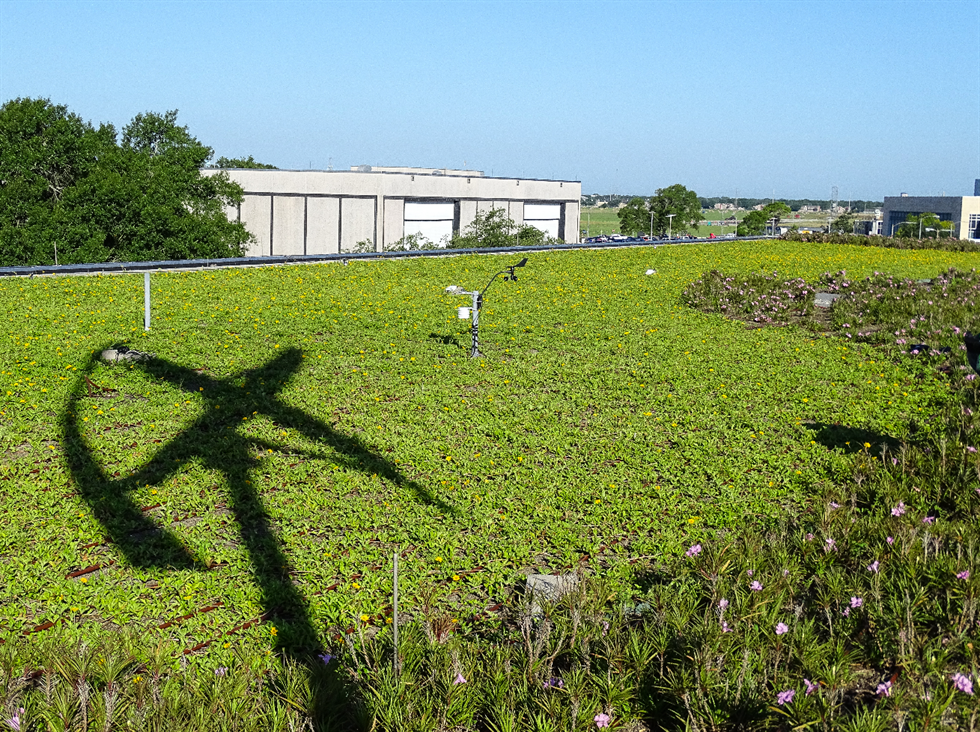A roof with a view
2017-11-28
Thanks to NASA Johnson Space Center’s grounds contractor, ProDyn, LLC, Building 12’s green roof is looking great again.
Aside from being beautiful, a green roof packs a lot of utility. Having vegetation atop a building, like on 12, helps reduce the overall temperature of the building without having to spend more electricity on air conditioning. This is because the vegetation absorbs heat from the surrounding air and releases it through evaporation. The heat and light are also used productively in the process of photosynthesis, which allows the plants to thrive and flower. According to the Environmental Protection Agency (EPA), green roofs can be as much as 90 degrees Fahrenheit cooler than conventional rooftops (EPA). This translates into massive savings for NASA, as a cooler roof also means a cooler electricity bill in the long run—as well as decreased load on the heating, ventilating and air-conditioning system.
Six species were originally planted on Building 12’s green roof in August 2013: Dakota mock vervain (Glandularia bipinnatifida), dwarf pink ruellia (Ruellia simplex “pink”), red stonecrop (Sedum moranense), rock point ice plant (Malephora lutea), Mexican sedum (Sedum mexicanum) and Angelina stonecrop (Sedum rupeste “Angelina”). None grew successfully, except for the ruellia. In 2016, all but the ruellia were removed and replaced with wedelia. Wedelia had been proven to grow successfully in conditions very similar to green roofs in Houston.
The first building at Johnson to boast a green roof, Building 12 is also one of the first Leadership in Energy and Environmental Design—or LEED—gold-certified buildings at NASA.
The green roof isn’t all that is exceptional about Building 12. The employees are, too. In 2016, they worked to decrease their energy usage relative to their own prior use, winning the JSC Energy Competition amongst other mall-area buildings.

Building 12's green roof has new plants. Not only pretty, the plants serve an environmentally friendly function. Image Credit: NASA
Stacy Shutts, Yong Yi, Jessica Moore and David Lie-Tjauw
NASA Johnson Space Center
Aside from being beautiful, a green roof packs a lot of utility. Having vegetation atop a building, like on 12, helps reduce the overall temperature of the building without having to spend more electricity on air conditioning. This is because the vegetation absorbs heat from the surrounding air and releases it through evaporation. The heat and light are also used productively in the process of photosynthesis, which allows the plants to thrive and flower. According to the Environmental Protection Agency (EPA), green roofs can be as much as 90 degrees Fahrenheit cooler than conventional rooftops (EPA). This translates into massive savings for NASA, as a cooler roof also means a cooler electricity bill in the long run—as well as decreased load on the heating, ventilating and air-conditioning system.
Six species were originally planted on Building 12’s green roof in August 2013: Dakota mock vervain (Glandularia bipinnatifida), dwarf pink ruellia (Ruellia simplex “pink”), red stonecrop (Sedum moranense), rock point ice plant (Malephora lutea), Mexican sedum (Sedum mexicanum) and Angelina stonecrop (Sedum rupeste “Angelina”). None grew successfully, except for the ruellia. In 2016, all but the ruellia were removed and replaced with wedelia. Wedelia had been proven to grow successfully in conditions very similar to green roofs in Houston.
The first building at Johnson to boast a green roof, Building 12 is also one of the first Leadership in Energy and Environmental Design—or LEED—gold-certified buildings at NASA.
The green roof isn’t all that is exceptional about Building 12. The employees are, too. In 2016, they worked to decrease their energy usage relative to their own prior use, winning the JSC Energy Competition amongst other mall-area buildings.

Building 12's green roof has new plants. Not only pretty, the plants serve an environmentally friendly function. Image Credit: NASA
Stacy Shutts, Yong Yi, Jessica Moore and David Lie-Tjauw
NASA Johnson Space Center







